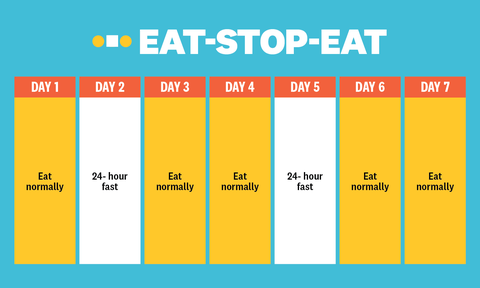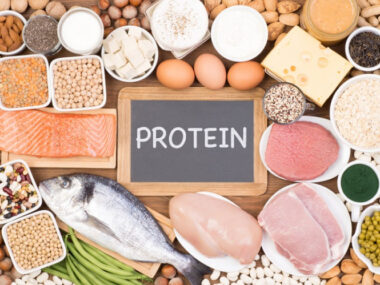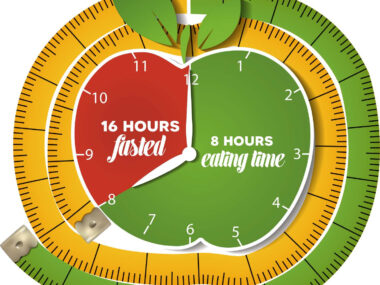When eating and fasting alternate periodically, it is called intermittent fasting.
It is common to abstain from food for durations that last 16–24 hours during intermittent fasting. A fasting cycle involves changes in metabolism and hormone levels as your body undergoes the fed-fast cycle.
Intermittent fasting not only results in metabolic changes, but it can also provide health benefits. A detailed examination of the fasting stages is presented in this article:

The state of the Fed
As your body digests and absorbs nutrients from food, you are in a fed state shortly after eating.
A high level of insulin is secreted during this period, which leads to an increase in blood sugar levels. Sugar is transported into your cells by insulin, which is a hormone in your bloodstream.It depends on how sensitive your body is to insulin, what you eat, how many carbs you consume, and how much insulin is released.
The liver and muscles store extra glucose (sugar) as glycogen. When needed, glycogen can be converted back into sugar for energy. Glycogen is the body’s primary form of stored carbohydrates. Leptin and ghrelin levels also shift during this period.
In the hours following a meal, you will see lower levels of ghrelin, a hormone that stimulates hunger. Meanwhile, after eating, leptin, which suppresses appetite, increases. If food is consumed during a fast, the fed-fast cycle is changed to fed.
The size and composition of your meal also affect your body’s state of being fed.
In summary
Immediately the following eating, a person enters the fed state. Leptin, ghrelin, and other hormones, including blood sugar and insulin, are affected, as well.
In the early stages of fasting
During the first 18 hours after eating, you are in an early fasting state.
The body converts glycogen into glucose (sugar) during this phase, using it as fuel. This phase is characterized by declining blood sugar and insulin levels.
Your body will start searching for another energy source as its liver glycogen stores run out. As a result, lipolysis intensifies, which is the process by which fat cells break down their triglycerides into smaller molecules for use as fuel.
In addition to converting amino acids into energy, your body also converts carbohydrates into energy. It is common for intermittent fasting methods such as 16/8 to cycle between the fed and fasted states.
The summary
Following a meal, your body enters an early fasting state, where glycogen, amino acids, and fatty acids are converted into energy.
Fasting state
In the fasting state, you will be fasting for about 18 hours to 2 days.
You are now breaking down protein and fat for energy, as your liver’s glycogen stores have been depleted. Fat is converted into fuel by your body, resulting in the production of ketone bodies. The body also enters a metabolic state called ketosis where fat is the primary energy source.
It is likely that ketosis will not occur immediately after entering the fasting state, but will likely take place later. When it comes to entering ketosis, your usual diet, and last meal, as well as individual differences, all play a role. Ketosis is characterized by decreased appetite, weight loss, fatigue, and fruity breath as well as increased blood, breath, or urine levels of ketone bodies.
In addition to the ketogenic diet, which involves drastically reducing carb intake, you can also achieve ketosis by following other methods. You should keep in mind that ketosis is not the same as ketoacidosis, a dangerous condition caused by an excess of acid in the blood.
Contrary to ketosis, ketoacidosis occurs when a person is sick, infected, or unaware of their diabetes.
In addition, forms of intermittent fasting that have shorter fasting windows, ranging from 12 to 18 hours, may not reach ketosis. Unless you also follow a very low-carb diet, fasts lasting less than 24 hours are possible.
SUMMARY
The fasting period lasts between 18 hours and 2 days. You enter ketosis during this state, which is a metabolic state of fat breakdown and energy production.
Starvation state (long-term fasting)
You enter the long-term fasting state after 48 hours of prolonged fasting when you do not consume food. The starvation state is sometimes referred to as this state.
Fasting for a long time will reduce insulin levels and elevate beta-hydroxybutyrate (BHB), a type of ketone body.
In addition to generating sugar, your kidneys also produce gluconeogenesis, which is your brain’s main fuel source. The brain receives energy from ketone bodies as well. Also, muscle tissue is conserved by reducing the breakdown of branched-chain amino acids (BCAAs).
-
It is recommended that long-term fasts should only be undertaken under medical supervision for most people.
The summary
When fasting is prolonged for more than 48 hours, the long-term fasting state is called starvation. As insulin levels decrease, ketone levels increase, and muscle tissue is conserved by reducing protein breakdown.
In conclusion
You will experience several phases of the feeding-fasting cycle during intermittent fasting, depending on how long you fast.
A fasting state is a transition from the fed state to the early fasting state, the fasting state to the long-term fasting state (starvation state).
Your body’s primary energy source and hormone levels vary during each phase. Talk to your healthcare provider before trying intermittent fasting if you have any underlying health conditions or are taking any medications.
Furthermore, prolonged fasting should only be undertaken under medical supervision.





